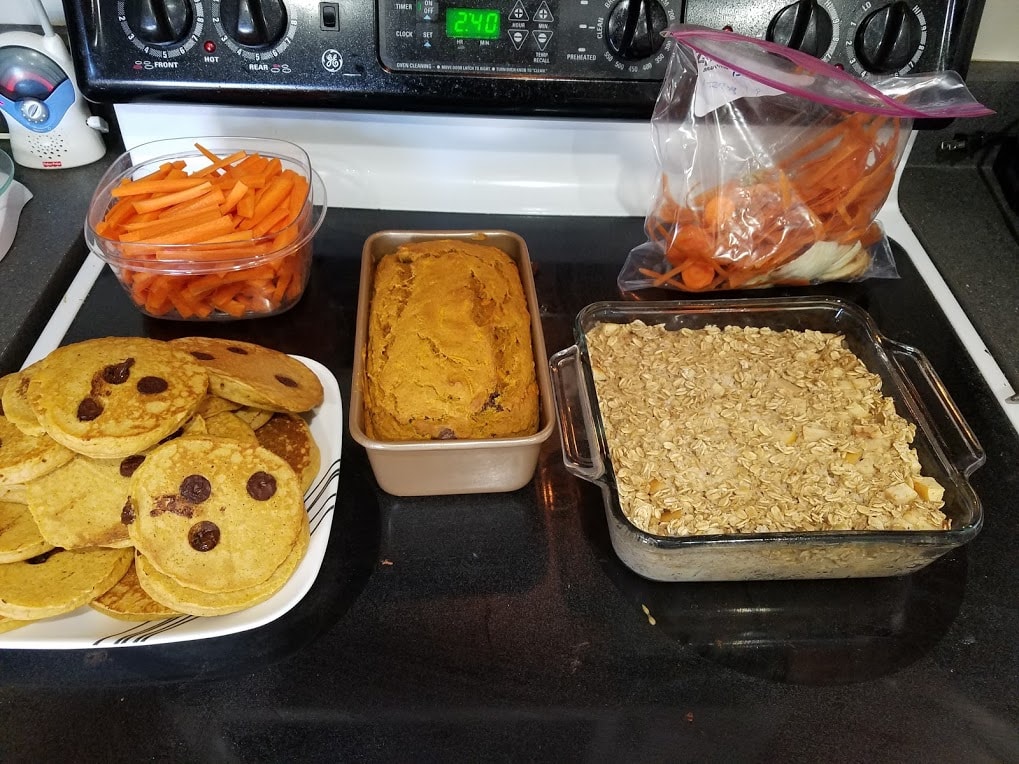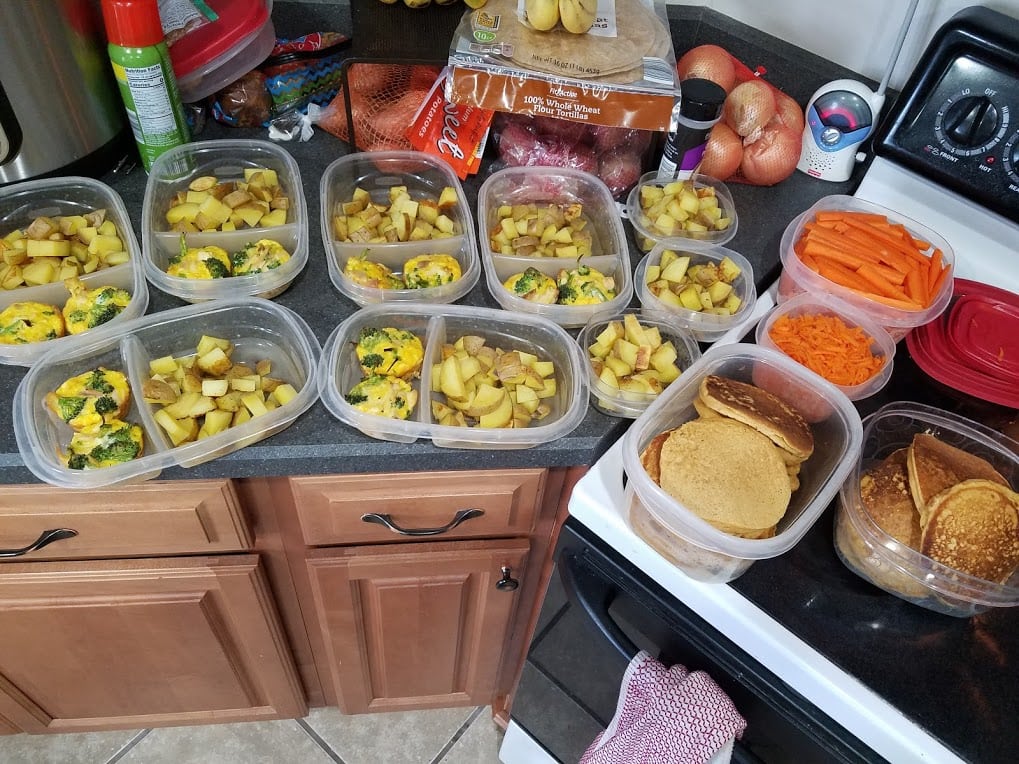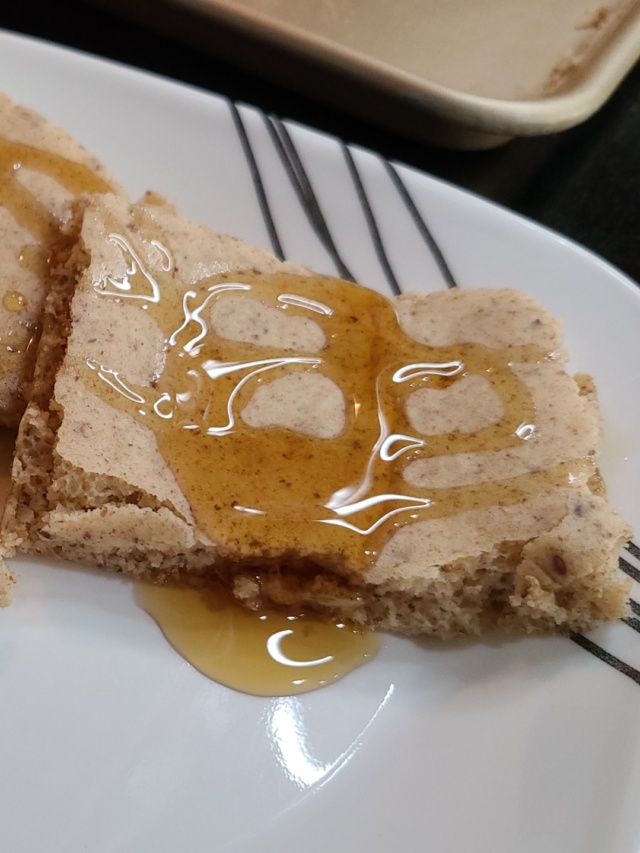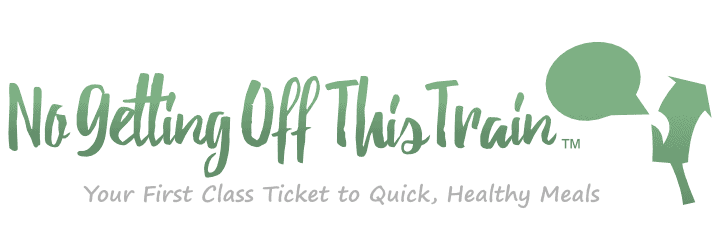Cooking can be hard when you have ADHD. Here’s how you can do an ADHD-friendly Sunday meal prep session to save time and stress!
When you hear the phrase “meal prep”, what comes to mind?
Spending 4 hours in the kitchen?
Scrolling Instagram and seeing a beautifully laid-out array of meal prep containers, all filled with an entire week’s worth of meals?
I used to think this was the only way to meal prep, and felt guilty when I simply couldn’t get all that accomplished.
And that might seem pretty overwhelming, even for a neurotypical person. But when you have ADHD, tasks seem even more enormous than they really are.

Are you desperate to have even a little bit of ready-made food to get you through the week? And still have a well-balanced diet? Let me show you how I do my Sunday meal prep in a way that works for my ADHD brain!

Benefits of meal prep
Tasks are harder in daily life with ADHD. Cooking, planning, etc. This is all due to one of the ADHD symptoms, having problems with executive function.
Our brains have issues with time management, take longer to process information and get started on tasks, so that can make things like cooking dinner super hard.
But I’ve found that doing a meal prep session every week has really cut down on my executive dysfunction and improved my mental health! Here are some of the benefits:
- Saves time: Even chopping up a few vegetables can shave off like 10 minutes of dinner prep. It doesn’t seem like much time; but when you’re tired and hungry in the evenings, every minute counts.
- Saves energy: I especially appreciate meal prep in the mornings, when I can just pull out an already-cooked breakfast instead of using brain calories figuring out what to eat.
- Saves money: If you have food already made, you’re more likely to eat that than go through the drive-thru and spend extra money. And you’ll save on food waste!
- Helps you eat healthy foods: With our executive dysfunction, we may not always have a healthy diet. Having foods ready to eat can help us keep on track.
How to plan a meal prep session
I usually plan my meal prep after I’ve created my weekly meal plans and grocery list. That way I know exactly what I have and what needs done.
Here’s my step-by-step list of how I plan my sessions. It’s important to note that I do this the day before, and not the morning of. For some reason, it makes me feel less stressed.
1.) Look at your calendar
Check your schedule for the upcoming week. Do you have evening meetings? Do you have to be at work earlier than usual?
Checking those appointments can help you decide what you should prepare ahead of time.
- Pre-chop all vegetables to save time on those busy evenings
- Cook a huge batch of baked oatmeal so you have an easy grab-and-heat breakfast every morning
2.) Choose a day to prep
My day for meal prep is almost always on Sunday afternoons. My husband John takes a nap, our daughter Allison watches TV, and I get my prep done.
Find a day and time that works for you. Maybe you’re a morning person, or maybe you have to wait until a Friday evening to do your prep. There is no wrong answer!
3.) Print out recipes
Make sure all of your recipes are printed and ready to go in the kitchen.
I used to just use my phone and pull up the recipes, but I found that was one extra step my brain didn’t have the energy for.
Now I realize I’m a paper gal, and need to have that recipe sitting right in front of me. It also helps me feel prepared for what I’m about to do.
4.) Grab entertainment
I’ll be honest- sometimes the thought of standing in the kitchen prepping food is a huge drag.
But if I have something to entertain me while I do it, the huge task doesn’t seem so bad.
I’ll put on some headphones and listen to a podcast, an audiobook, or even some upbeat music. It’s like a distraction while I do something I may not want to.
And honestly, I do this almost everywhere. When I go out for a walk, when I’m driving somewhere, cleaning the house… the constant stimulation helps me focus and work better.

How long I spend on meal prep
Remember above, where I mentioned thinking about those 4-hour meal prep sessions?
Yeah, there’s no way I could do that.
If you’re in hyper-focus mode and really love what you’re doing, then maybe. But in a general setting, there’s no need to cook that long.
My goal is to be finished in less than an hour. And honestly, a lot of that time is just waiting for the food in the oven to finish.
That’s why having a plan is important. I know what I’m supposed to be doing, and I’m not wasting time in the kitchen when I could be doing something else I like- like working on my cross stitch.
Easy foods to prep
So now that I’ve gone through how to meal prep, what are some GOOD foods to prep?
I’ve been doing Sunday meal prep sessions for years now, and I’ve found that some foods are easier and more enjoyable than others. Here are examples of things I do on a regular basis:
- Wash fruit, like berries and grapes
- Make baked oatmeal or an egg casserole, which bake for around 40 minutes
- Chop up simple ingredients and vegetables, like a head of broccoli or Romaine hearts for salad
- Make a huge batch of pancakes for the week
- Cook rice or quinoa in my rice cooker
- Cook and shred chicken breast to freeze for later
- Bake sweet potatoes for side items or as a main dish

How to prep based on energy levels
Let’s face it: You’re not going to have the same amount of energy every week.
I’ll be the first to admit that I let my emotions dictate my energy sometimes. If I’m stressed about something later in the week, my brain won’t let me do a lot of productive things.
Because of this, I’ve labeled things in my life into 3 categories:
- High energy
- Medium energy
- Low energy
This can revolve around my daily tasks. If it’s a high energy day, maybe I can clean the entire bathroom. But on a low energy day, maybe I just wipe down the toilet.
Same goes for cooking. If I know I’ll have a high-energy day or week, I’ll chop up a bunch of produce. But on low-energy weeks, I’ll buy pre-chopped produce.
And I know that it’s not possible to gauge your energy levels correctly every day. Sometimes you’ll get into a rhythm and know when your body’s not going to cooperate. Just do your best and give yourself grace when you don’t have the energy you thought you did.

Beginner-friendly recipes
I’ve gathered a list of what I call “Low energy recipes”. These are easy meals that can be put together pretty quickly with not a lot of effort.
I also tried to make them well-balanced nutritionally:
- Lean protein
- Whole grains
- Healthy fats
It’s not always perfect, but every little bit helps! Hopefully you’ll find some new recipes to try:
- 5-Ingredient Salsa Verde Chicken
- Sheet Pan Pancakes
- One Pot Cheesy Pasta
- Peanut Butter Banana Overnight Oats
- 4-Ingredient Slow Cooker Ranch Chicken
Final thoughts
Meal prep CAN be done when you have ADHD! It might look a little different and it may not be super fancy. But if it gets the job done, that’s all that matters.
Leave a comment and tell me: What tips do you have for managing your ADHD and meal prep?
Other helpful resources

Jaime is a Nutrition Coach through the ISSA and professional writer. She has 4 years experience coaching and 9 years experience in writing. She enjoys cooking easy meals, running, and learning more about food.
Jaime specializes in helping women with ADHD learn to meal plan and cook healthier meals without getting overwhelmed.
